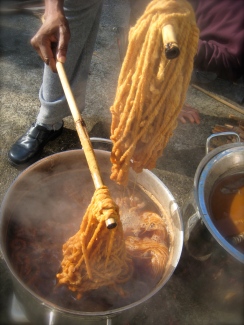Winter Dyes
December 7, 2009
The morning began with a 1/2 inch layer of frost on the kale leaves. The cold was welcome, as it seemed to keep the rain at bay for a couple of days so we could complete our dye work. We began by preparing alum and tannin baths, followed by a long hike into the watershed to look at coffeeberry and toyon in the wild, and then returned to the dye studio to prepare pre-cut branches that were gathered the day before. Students worked to light fires of the rocket stoves—these are a wonderfully efficient heat source, that bring water to a rapid boil.
The second day we worked with Toyon and Coffeeberry vats we had prepared the day before, as well as older vats of the same species that had been curing for weeks before the class began. The above vat is an aged toyon that provided lovely orange/rust colors.
This was the fresh coffeeberry vat–made in a copper pot which created variations of yellow and bright khaki greens.
The second day ended with a beautiful array of colors–that came from two beautiful winter harvest species, no modifiers, and only an alum mordant. The dyes are shown on a superwash merino sock yarn, and a DK weight merino yarn.
Cotton flour sacks were first mordanted in tannin, and then alum. This pre-mordant combination created strong colors on the cellulose fiber– akin to the colors created on the wool.
Aged toyon, a fresh toyon dye, and a brief dip in the new and old coffeeberry vats are reflected beautifully in these handspun yarns. The color of our yarns were observed to be the exact shades of the turning maples that framed the garden– yellow-green-and orange.

The third day began with some wonderful knitting instruction, that included a little history along with very clear technical support from Heidi Iverson. Ball winding was the first order of business, followed by instruction in how to work with circular knitting needles- we cast on, and the knitting began. More pictures of our winter cowls to come– as they are completed.
The final joy of the workshop was had when our maple prints were unfolded. After a long dip in the tannins, and an overnight soak in iron—this completely amazing print was unravelled.
Another close-up of the flour sack– turned fine art. Overall, a wonderful three day dye experience was had.. A time of gathering– for both plant and human, and a time of color.









December 8, 2009 at 11:28 pm
i love seeing the smiling dyers.
have you used these stoves long enough to endorse them? and will they work outside in very cold weather?
December 9, 2009 at 2:05 am
Hi Velma,
I really recommend the stove- once started, they boil water faster, than an electric burner, and are much more economical. You can use wood scraps, roots and garden waste as fuel.
Thanks for asking!
May 14, 2017 at 11:01 am
Woah nelly, how about them aplsep!
May 14, 2017 at 11:40 am
I’m grteaful you made the post. It’s cleared the air for me.
December 9, 2009 at 12:05 am
Wonderful tour of your three days of dyeing! I love the colors from toyon and coffeeberry.
December 9, 2009 at 2:06 am
Thank you for your lovely feedback– I hope to get more pictures up soon- of finished goods..
December 15, 2009 at 9:45 pm
great to see this winterdyeing – have to check that adress about the stove (I know you have a kink to it somewhere in your previous posts). And the result of the ecoprint is a beauty, Dorie
May 14, 2017 at 11:00 am
Woot, I will ceitnraly put this to good use!
August 30, 2017 at 9:37 pm
0 5Wie allgemein bekannt, habe ich so meine Probleme mit diesen knallharten Männersportarten wie: Synchronschwimmen für Männer, Federball, Eiskunstlaufen, Ballett.Auch Chinlone gehört dazu, da kann ich als Mann nicht genug meine weiblichen Empfindungen zur Geltung bringen.Deswegen als Frauenversteher und Kämpfer für die Frauenrechte, werde ich diesen knallharten Männersport Chinlone hassen.